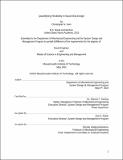| dc.contributor.advisor | Seering, Warren P. | |
| dc.contributor.author | Hein, Christopher N. | |
| dc.date.accessioned | 2022-11-01T20:19:27Z | |
| dc.date.available | 2022-11-01T20:19:27Z | |
| dc.date.issued | 2022-05 | |
| dc.date.submitted | 2022-06-23T14:12:41.508Z | |
| dc.identifier.uri | https://hdl.handle.net/1721.1/146073 | |
| dc.description.abstract | Warships are highly complex and complicated systems that are designed in the present to address problems that will exist decades in the future. Because of the significant time gap between preliminary design and the end of the ship’s service life, it is critical that it be built with flexibility in mind. In this context flexibility is the measure of a ship’s ability to be upgraded quickly and cheaply to efficiently respond to a known or unknown perturbation. With enough time and money, a warship can be altered to respond to almost any eventuality. The difficulty lies in constructing warships with future uncertainty in mind and in such a manner that they can be upgraded quickly and cheaply. Put more simply, the difficulty lies in designing warships to be flexible.
Taken a step further, the challenge is to design a ship that is “flexible enough” and in the right areas. As it stands, while flexibility is a desirable characteristic in ship design, the Navy does not have a robust methodology to design for it. While it is often a consideration or recognized as an emergent property, there are no recognized, quantitative metrics, KPIs (Key Performance Indicators), or processes that designers can rely upon to ensure that a ship is flexible on delivery. This study provides a new way to think of flexibility that will allow ship designers to quantify and categorize the measure of a warship’s flexibility in the face of future uncertainty through the use of a “flexibility framework” that is both quantitative and repeatable. | |
| dc.publisher | Massachusetts Institute of Technology | |
| dc.rights | In Copyright - Educational Use Permitted | |
| dc.rights | Copyright MIT | |
| dc.rights.uri | http://rightsstatements.org/page/InC-EDU/1.0/ | |
| dc.title | Quantifying Flexibility in Naval Ship Design | |
| dc.type | Thesis | |
| dc.description.degree | S.M. | |
| dc.description.degree | Nav.E. | |
| dc.contributor.department | Massachusetts Institute of Technology. Department of Mechanical Engineering | |
| dc.contributor.department | System Design and Management Program. | |
| mit.thesis.degree | Master | |
| mit.thesis.degree | Engineer | |
| thesis.degree.name | Master of Science in Engineering and Management | |
| thesis.degree.name | Naval Engineer | |
